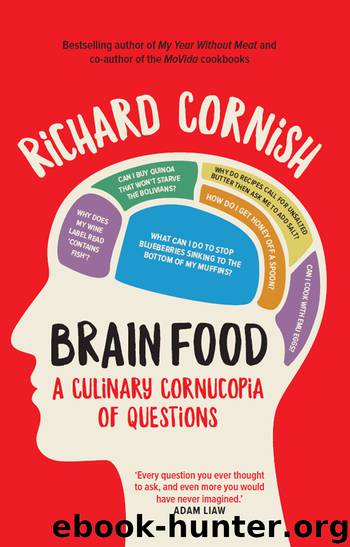Brain Food by Richard Cornish

Author:Richard Cornish [Cornish, Richard]
Language: eng
Format: epub
ISBN: 9780522871135
Publisher: Melbourne University Publishing
Published: 2017-04-08T04:00:00+00:00
10
Herbs and Spices
In the Middle Ages people used spices to hide the fact that their meat was rancid. WHAT A LOAD OF BOLLOCKS! You would know about racism from listening to talkback radio. You would know about ageism from the way people speak to old people like they are mentally challenged. How about the concept of ‘era-ism’? We ascribe certain values and behaviours to people from eras gone by that make them seem quaint and different. We make people from the past ‘the other’. At the start of the Renaissance in Europe, spices such as cloves, nutmeg, pepper and cinnamon were highly regarded in the homes of the rich. Spices were precious and prestigious. They were used to flavour desserts, fruit pastes and venison pâtés. The more you could put in a dish, the more you were worth. Putting a little bit of spice in a dish was for flavour. Putting a lot in a dish was like turning up to an event in a brand new Porsche Cayenne. So spicing in the past was a way of sharing your wealth. Animals were slaughtered, butchered and cooked in rapid succession.
These days it costs $2.33 for a small jar of decent quality cinnamon. For $5 you can get really good quality cinnamon. For $7 you can get really bad fake cinnamon. For $5 you can buy some not-so-good supermarket parsley. For a few cents you can grow your own. There has always been a huge difference in the quality of spices that are available to buy, and growing your own herbs has always been a great, and reliable, alternative to buying them.
How can I learn to love coriander? It tastes like soap! A. Creber
Don’t worry. It’s genetic. You are not alone. If you don’t like coriander you are among a small but significant percentage of people who hate it. Compared to most people you have slightly different olfactory receptors that make the aromas of coriander unpleasant. According to the scientific journal Nature, 21 per cent of East Asians, 17 per cent of people of European ancestry and 3 to 7 per cent of people of South Asian, Latin American and Middle Eastern descent do not like the taste of coriander. It seems to be a long-standing genetic trait; the word ‘coriander’ comes from the Greek koris, meaning ‘bed bug’, as some ancients compared the herb’s aroma to the smell of clothes infested with bed bugs. The rest of us, however, love the stuff.
Where can I find epazote? M. Diaz
Epazote is a herb common in Mexican cooking, often found in quesadillas, and is one of the 40 or so ingredients used to make a traditional mole. It has an aroma that is a cross between mint, tarragon and old creosote posts, and that adds a wonderful fresh, high note to Mexican food. You can buy it online at spice retailers such as fireworksfoods.com.au. For live plants search nurseries online for ‘Mexican tea’ or use its botanic name, Dysphania ambrosioides. Despite epazote being
Download
This site does not store any files on its server. We only index and link to content provided by other sites. Please contact the content providers to delete copyright contents if any and email us, we'll remove relevant links or contents immediately.
A Court of Wings and Ruin by Sarah J. Maas(7264)
The Sprouting Book by Ann Wigmore(3409)
Better Homes and Gardens New Cookbook by Better Homes & Gardens(3371)
The Death of the Heart by Elizabeth Bowen(3342)
BraveTart by Stella Parks(3307)
Salt, Fat, Acid, Heat: Mastering the Elements of Good Cooking by Nosrat Samin(2998)
Sauces by James Peterson(2964)
The Bread Bible by Rose Levy Beranbaum(2887)
Classic by Mary Berry(2834)
Kitchen confidential by Anthony Bourdain(2831)
Solo Food by Janneke Vreugdenhil(2823)
Ottolenghi - The Cookbook by Yotam Ottolenghi(2738)
Martha Stewart's Baking Handbook by Martha Stewart(2676)
Betty Crocker's Good and Easy Cook Book by Betty Crocker(2598)
Day by Elie Wiesel(2593)
My Pantry by Alice Waters(2434)
The Plant Paradox by Dr. Steven R. Gundry M.D(2427)
The Kitchen Counter Cooking School by Kathleen Flinn(2396)
Hot Sauce Nation by Denver Nicks(2369)
